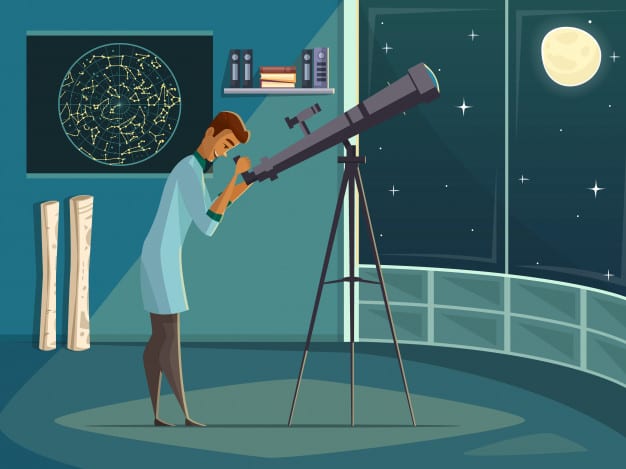Optical Concepts Explained: How do Telescopes Work?
August 7th, 2019
by Andreea S.

What do you see when you stargaze at galaxies far, far away? And what invisible mysteries can you unravel when you look through a microscope?
The science of optics and magnification may be a bit confusing for some. Beginner astronomers wanting to try their first telescope or young scientists discovering the microcosm of things need to get some facts clear before they get their hands on the optical instruments of their choice.
We will discuss magnification today and understand better not only how do telescopes work, but binoculars, microscopes, and magnifying glasses as well, as there is more to these optical concepts and instruments than the eye can see.
A Few Details on Magnification
The magnification definition is simple to understand, and we think most of us remember it from the Physics class in high school.
- Magnification represents the process of enlarging – visually, not physically – an object. The said subject does not become larger per se, but larger in appearance.
Now it is an excellent time to stop for a short break and understand the difference in between telescope magnification and microscope magnification, as they work in entirely different ways.
- Telescope magnification: it is the process of making a distant object appear closer, and thus more precise and more detailed.
- Microscope magnification: it is the process of making small objects appear more extensive, and thus more detailed.
Now that the break is over, we need to discuss magnification from a practical point of view. What does it mean when you want to buy an optical instrument for your hobby?
Optical Magnification
If you browsed our articles and reviews on best telescopes, best microscopes, or best binoculars, you saw a handful of numbers associated with each product. One of the most significant such numbers relates to optical magnification, a critical criterion you have to factor in whenever you want to get an optical instrument.
- The optical magnification of an instrument describes the ratio between the height of the image you see and the height of the real object you magnify.
Optical magnification is a dimensionless number more often than not confused with optical power (which describes the degree to which an optical system can converge or diverge light).
- When you see a number such as 10 X for an optical instrument, you should know that it makes the object appear ten times larger than its actual size.
- The larger the magnification number is, the larger you will see the item.
Focal Length
Also, a critical element to consider when you shop for optical instruments, focal length describes how strongly (or weakly) a visual tool is capable of converging or diverging light.
- The focal length is the inverse of optical power.
Without insisting on complicated definitions, formulas, and physics, let’s say that the focal length number on an optical instrument helps you not only understand better how it works, but also how well it works according to your needs.
Telescope and Binocular Magnification
We use telescopes and binoculars to observe objects far away. Astronomical telescopes help us see objects at indescribable distances.
- Longer focal length (and subsequently lower optical power) allows you to benefit from higher magnification and a narrower field of view. It helps you see more details of a specific object, like the Moon’s craters.
- Shorter focal length (and subsequently higher optical power) means lower magnification but a broader field of view. In astronomy, it is a crowd’s favorite, as it means you can take the night’s sky all in and you can observe open star clusters, nebulae, or galaxies.
Microscope Magnification
We use microscopes to enlarge the object and bring it closer to the lens.
Shorter focal length (with higher optical power) means we achieve higher magnification levels because the object is brought closer.
Magnification vs. Resolution
We think it is time to take yet another short break and discuss magnification vs. resolution, as many people do not know they are co-dependent and equally important, mainly when you consider microscopes. So let’s see what does what in the field of optics.
- Magnification, as we saw above, is an instrument’s ability to make large objects look closer or smaller.
- The resolution, on the other hand, is a system’s ability to distinguish two objects from one another. If you ever took low res photos with a camera or phone in your life, you know that without a proper resolution, things appear like a blurry mess. Resolution is the one making objects appear in precise detail.
In short, the better the resolution an optical instrument has, the more useful becomes its magnification power.
You can observe this the best with microscopes. There is no use in having a microscope with tremendous magnification abilities if the images you get resemble a pile of mush. It is the resolution that gives you all those gorgeous details of microscopic objects.
Lenses, Lenses Everywhere
Before we get into even more details on optical concepts and optical engineering, we need to talk about objectives, lenses, and eyepieces, as they make essential elements in the understanding of how telescopes work.
- Objectives represent an optical instrument’s parts able to gather light from the object you want to observe and focus the light rays so you can see a real image.
- In the category of objectives, you can find simple lenses, simple mirrors, or a combination of multiple optical elements.
- You will find objectives in microscopes, telescopes, and cameras. You will also find them in slide projectors and even CD players (as out of fashion as they may seem).
When we discuss microscope magnification, for instance, we have to understand that at their core, the objective lens of a microscope is, in fact, a simple high-powered lens – basically, a magnifying glass with a very short focal length.
- A microscope can feature multiple objectives, which, in turn, consist of several lenses.
- The humblest lens is probably the magnifying glass. As we go further on the ladder of complexity, we reach the telescopes.
And now, it is time to understand more about how telescopes work and how their optical peers function by comparison.
How do Telescopes Work?
We have talked about telescopes and their tech specs and features a few times before, but today we will focus on how they work and what optical concepts you need to consider before you buy an astronomical one or a terrestrial one.
- Astronomical telescopes help us see a magnified image of far celestial bodies such as planets, stars, satellites, clusters, nebulae, and even galaxies.
- Terrestrial telescopes help us see the magnified image of, well, terrestrial objects.
Types of Astronomical Telescopes
The telescopes you find today, from the toy ones to the Hubble itself, come in two major types, depending on the two major types of lenses they use.
Refractor telescopes feature glass lenses
Just as eyeglasses and magnifying glasses, glass lenses in refractor telescopes bend the light passing through them allowing for a less blurry image, making the far-away objects appear closer.
Reflecting telescopes use mirror lenses
- Mirror lenses concentrate light that bounces off them.
- They are more comfortable with making, are thinner and lighter in comparison to glass lenses, but they come with a downside: they invert the image, just as spoons do.
The answer to altered images is that telescope manufacturers use other mirrors to flip them back.

Glass Lenses vs. Mirror Lenses
The quality of a telescope, when optics are concerned, lies with the size of the lenses, no matter if glass or mirror.
- Big, thick glass lenses are the best for you to see far away objects. Unfortunately, such huge lenses are cumbersome and extremely expensive.
- Also, unfortunately, the thicker the glass, the smaller the quantity of light passing through it. Moreover, for excellent results, the surface of a glass lens needs to be flawless, as nobody likes to gaze through dirty windows.
- Mirror lenses are thinner by construction. The best part is that massive mirror lenses do not necessarily need to be thick, either. All they need is the right curvature.
- Modern telescopes you find on the market are usually the reflecting type. They are lighter and easier to carry and clean.
Whenever you search for a telescope, you need to consider these two main questions:
- How well does the telescope collect light?
- How much can a telescope magnify an object?
Since we discussed lenses and magnification already, let’s try bringing things home.
- For you to understand a telescope’s ability to gather light, you need to look at its aperture – the diameter of the central glass or mirror lens.
- The larger the aperture, the more light the telescope gathers, and the brighter the image are.
Aperture is even a more critical feature than magnification according to specialists.
Since all telescopes use eyepieces to achieve magnification, you need to look deeper into the aperture tech specs, especially if you want a telescope for night stargazing.
The Basic Mechanism of How Telescopes Work
- A refractor’s objective lens (or a reflector’s primary mirror) gather as much light as it can from a distant object in the sky and brings that light (image) back to a focus point.
- The eyepiece lens of your telescope then takes the light from the focus point of the objective lens or mirror and then magnifies it so it can take as much space as possible on your retina so you can see the image closer, clearer, brighter.
We hope we made it more explicit for you how telescopes work. Before we move on to our next optical concepts and explanations, make sure you browse our articles to find the best telescope for your needs!
Telescopes Trivia and Things to Know Before You Purchase One
When you browse the market for telescopes, you usually find all sorts of names and labels to them. Let’s explain some telescope trivia and functions so you can make a better-educated choice!
- Galilean telescopes – they are refractor telescopes (glass lenses) developed by Galilei, who was the first one to use them for astronomy, even though the credit for the first refractor telescope goes to Hans Lippershey, who developed such instrument in 1608 and made it available for the military;
- Kepler telescopes – also refractor telescopes improved by Kepler, who worked on the glass lenses design and uses. While refractors benefitted from many upgrades since the 1600s, Kepler’s design and concept still represent the basis of refractor telescopes you can buy today.
- Newtonian telescopes – reflector telescopes (mirror lenses) that are extremely popular even today.
- Dobsonian telescopes – they are Newtonian reflectors with design upgrades, in the sense that they feature simple tubes and alt-azimuth mounts as opposed to equatorial mounts.
- Catadioptric telescopes (compound) – they mix glass lenses and mirrors. The first compound telescope appeared around 1930, made by German astronomer Bernhard Schmidt, and made a name for itself in photography. In the 1960s, the Schmidt – Cassegrain design revolutionized the field of astronomy telescopes, being, to date, one of the most popular telescope models on the market.
- The Maksutov telescope – also a compound one, it bears the name of Russian astronomer D. Maksutov, who made upgrades to the previous designs in terms of lenses. Today, a Maksutov – Cassegrain design is similar to the Schmidt – Cassegrain one, but you should expect more spherical corrector lenses.
Before we go, we have to say a few things about consumers’ expectations regarding telescopes
It is highly unlikely you will be able to find or buy a product with the capabilities of the Hubble telescope.
- Mass-market astronomy telescopes, however, feature incredible tech specs so you can see not only the Moon on a clear night’s sky, but also clusters, nebulae, and even galaxies.
- The best part is that even kids’ telescopes nowadays make small pieces of high-tech jewelry when it comes to aperture, magnification, design, and quality of lenses.
Children and beginner astronomers have to understand that while they will not be able to see space as NASA does, they will still be able to see terrestrial and celestial bodies at unprecedented quality.
Now let’s discuss in short other optical concepts and see how other optical instruments work, besides how do microscopes work, now that we laid the foundation for magnification, lenses, and other tech specs.
How Does a Magnifying Glass Work?
As we suggested above, the magnifying glass is the primary optical element we use to see objects more sizeable than they are in reality.
- The most uncomplicated magnifying glass uses a convex lens (glass) that allows light to go through it but converges the light rays to make things look larger.
If you ever used a magnifying glass to make fire (or saw this process in movies), you know that magnifying glasses can concentrate sun rays into a point of focus to create a hot spot that can ignite a fire.

How Do Binoculars Work?
Most people think binoculars are smaller telescopes we use with two eyes, but things are not as they seem. While using the same optical concepts of magnification and objective lenses, binoculars, as we mentioned in a previous occasion, work differently from telescopes. Here is how!
- The binoculars’ objective lens captures the light (image) from the object you observe and brings it back to the point of focus.
- The image collected by binoculars is inverted, as binoculars use two convex lenses in series (for each eye), and the light crosses over, leading to an upside-down image.
- The light goes through two prisms – optical elements meant to take the light from the convex lenses and flip them 180 degrees. The prisms sit between the objective lens and the eyepiece lens.
- The reverted image then goes past the prisms and reaches the eyepiece, which magnifies it and allows you to see a large, sharp image of an object at a distance.
In case you are wondering how you see only one image instead of two – as you use both eyes when you look through binoculars – you need to consider the depth of field.
It represents an optical concept describing the merger of the two images into a single one. If you want to figure out more about how vision works and get better clues on how binoculars work, check out this article on eyesight!

How Does a Microscope Work?
We have talked about how microscopes work before, and throughout this guide, so it is time to summarize things!
The simplest microscope is a magnifying glass featuring a single convex lens able to gather light and converge it, magnifying the captured image 5 to 10 times.
Nevertheless, most microscopes used in schools, at home, and in professional labs are compound microscopes, using a handful of lenses in both the objective lens and the eyepiece.
Microscopes work a bit different in comparison to their optical peers.
- They need light coming from the bottom to light up an angled mirror and, changing direction, to travel straight upwards the specimen in question.
- The light coming from the mirror passes through the slide, the specimen on the slide, and the coverslip, reaching the objective lens.
- The objective lens achieves the first stage of magnification – it uses its lenses to spread the light coming from the specimen, so the image appears to come from a much larger object.
- This light then reaches the eyepiece, which also magnifies the image as a magnifying glass does.
One of the best parts about microscopes is that they offer you plenty of control so you can move the lenses, adjust the focus of the image you see, and fine-tune other elements so you can observe the microcosm in its full wildness and beauty.
Compound microscopes can show you images of tiny, invisible objects, at 10, 20, 40, or 100 times magnification levels. Of course, the most powerful ones, like electron microscopes, can magnify by 1000 times or even more.
Don’t for a second think that hobby-related microscopes or those used for teaching and fun are of low quality. On the contrary, many mass-market microscopes for kids have amazing tech specs and magnification powers.

How Do Telescopes Work: Bottom Line
Now that we saw how do telescopes work and discussed plenty of optical concepts and optical instruments’ features, it is time for you to take the stage! Did you ever use a telescope or a microscope?
Do you own a pair of binoculars for events, outdoor explorations, or preparedness? What other topics in the magnification and optics department would you like to see discussed here? Feel free to use the conversation section below!
Want more science now?
Check out our news page where we post interesting studies and discussions (sometimes mocking them mercilessly) for more.
